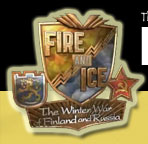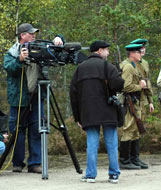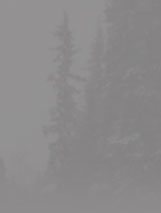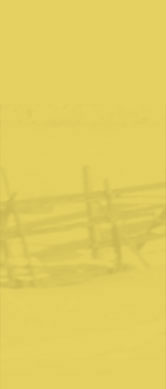

Our plane landed in Amsterdam on April 13, 2004, 4:00 pm almost 20 hours since we had left home in Indianapolis. We immediately headed for our connecting flight to Helsinki. After months of research and planning, we were anticipating our first experience of Finland.
At the gate, we came upon a large group of teenage girls waiting for the flight. They spoke excitedly in a strange-sounding language that seemed somehow familiar, yet like nothing I had ever heard before. Still jetlagged, it took a while to realize I was listening to Finnish for the first time. The girls wore a team uniform and carried a large trophy. Most spoke excellent English. I learned they were cheerleaders back from winning an international high school competition in San Diego.
Arriving in Finland
First impression, as the airplane descended from 30,000 feet, was of a flat terrain, somewhat like Indiana. As we got closer, I saw it was covered by a dense carpet of pine forest - the trees tall, straight and pencil thin. Landing, I was struck by the light - its crispness and clarity. The day was warm, yet there were still patches of snow on the ground. Driving into the city, we passed bays and lakes still frozen solid.
Helsinki is a modern city. Its streets are clean and uncluttered. There are wide boulevards with crowds of pedestrians. Traffic flows freely but with a smaller proportion of automobiles than in the United States. There are an abundance of transportation options - trains, buses and trolleys. The city center has retained a great deal of its historically significant architecture. Many of the buildings have stucco exteriors painted in pastel colors. There are also many very modern, glass and chrome structures, such as the one housing the city’s largest newspaper. From my hotel room, I looked out at the central train station’s plaza, and streams of passengers rushing to waiting buses, trolleys and the nearby underground metro. To the right was the huge main post office building. Later I learned that during the Winter War, the roof housed anti-aircraft batteries.
The next morning was slate gray. A cold wind whipped the flags and pennants on the rooftops. I put on my winter clothes and made my first attempt to navigate the city on foot. With a tourist map provided by the hotel, I tried to decipher the strange polysyllabic street names. I began to gain a mental map of my surroundings. The city center was a series of concentric circles around the main train-bus-metro-tram transportation hub.
Getting Started
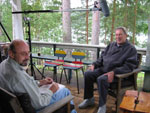
Interviewing
survivors.
Ben Strout
Shooting our initial interviews was easy because so many Finns are fluent in English. Most speak several other languages as well and are able to switch from one language to another with ease. Our Finnish crew’s technical proficiency with our HDCam equipment made production much easier.
Our return mission to Finland in September was more challenging. Our plan was to drive across most of Finland, then switch to a Russian bus and driver to take us across the Russian border.
At the car rental agency, we discovered that the large van we had expected was a Volkswagen mini-van, not nearly large enough for our crew and equipment. So we rented a second car. The price of gasoline, along with the price of just about everything, was a constant shock because the dollar had recently dropped to a third of its value against the euro.
Finland’s highways were in remarkably good condition - in spite of their extreme winter weather. We were able to navigate with few problems.
The most remarkable experience was Suomussalmi’s Winter War Monument. It is a field with twenty-thousand rough cut chunks of stone strewn about, each stone representing one fallen soldier. At the center is a wooden sculpture, with 105 bells at the top, one for each day of the Winter War. They ring eerily as the wind blows. Further down the Raate Road, there is another memorial, beside the mass graves of the soldiers of the Ukrainian 44th Division. Right above the memorial, the branches of a tree are strangely twisted- the only one like this within a forest of ramrod-straight pine and birch.
Battling Bureaucracy
Or biggest challenge, however, turned out to be Russian bureaucracy. Our shooting schedule allowed five days to drive from Helsinki across the post-war border, film the old battlefields in Karelia, film some scenes in St. Petersburg, Russia, then return to Helsinki. We had carefully prepared our visas and a customs declaration for the film and video equipment, called a carnet.
Our Russian driver brought us to the border late - about 8:00 pm. We sailed through the Finnish side. But the Russian customs officials refused to accept our carnet because it was written in English. They insisted that it had to be translated into Russian. All supervisors had gone home for the night and we were not allowed to enter Russia. We had no choice. If we went back to Finland, our one time entry visas would have become invalid. We were stuck in the no man’s land between the Finnish and Russian borders for the night.
The next morning, our Russian guide managed to convince an official in the nearby city of Vyborg to issue a temporary entry permit. But we were required to get an official entry permit in St. Petersburg in order to obtain an official exit permit for our equipment.
Driving through Russian Karelia, the contrast to Finland was immediately apparent. The roads had many bumps and holes. Unlike Finland, which was spotless, Russia Karelia had trash strewn on the sides of the highway. Many of the homes in rural villages were in immediate need of repair. But they were in far better shape than the crumbling concrete apartment buildings we saw in some of the cities. We passed family farmers hand picking potatoes from their fields. On the weekend, the forests were full of mushroom and berry hunters. It was a huge contrast to the new multi-million dollar homes we would see later approaching St. Petersburg.
Stepping Back in Time
In Summa, at the most strategic point of the Mannerheim Line, now a Russian military base, time temporarily shifted to September, 1939.. Here we would stage the military build up that preceded the Winter War. Fifty soldiers arrived by bus from St. Petersburg. Most were in their 20s or early 30s, members of re-enactment clubs. Each had adopted the persona of a 1930’s soldier. Two thirds were Red Army, and one third was Finnish Army. All were period correct - from their uniforms and weapons, to their hand rolled cigarettes, to their musical instruments and hand cranked gramophones. The Russians drilled. The Finns built trenches. They made camp and cooked meals. They sang and danced.
Time retreated as we approached another important battlefield of the Winter War, the killing fields of Taipale. To reach it, we crossed a river on a makeshift ferry made from a section of an old military pontoon bridge, powered by an ancient engine. In 1939, hundreds of Soviet soldiers had been killed, trying to cross the river at this same spot.
After four days of filming, we drove to St. Petersburg to complete the customs procedures that would allow us to exit Russia. What should have been a formality became another 24 hour ordeal. When it was all over, we had less than an hour to shoot scenes of the incomparably beautiful city of St. Petersburg, then lots of time to regret this loss- all the way to Indiana.
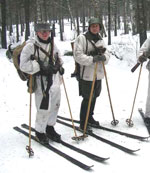
Finnish
soldier reenactors.
Ben Strout
We
returned to Finland in February. We brought our Russian reenactors
to Finland and. augmented our U.S.
based crew
was with
a second Finnish
video crew, Finnish stuntmen, a Finnish special effects team and
members of the Finnish Reservists Association in white camouflage
on skis. In the next few days, we blew up tanks and troops and machine
gunned charging soldiers in the deep snow and sub-zero temperatures
of a reconstructed battlefield.
Coping with the Cold
Cinematographer Michael Bowie’s plans to deal with the cold included large Ziploc bags, insulated containers, lots of batteries and a hand-held hair dryer. Each night he put the camera equipment into Ziploc bags, then into a Styrofoam cooler. Then, when we went indoors, condensation would form on the outside of the bag - away from the electronics. Each morning, before he started shooting, he took the camera outdoors and let it acclimate inside the cooler before taking it out of the plastic bag. The hair dryer helped defrost some of the controls on the Jimmy Jib - and sometimes fingers and toes. Batteries were another problem because they lost efficiency in the cold. Spare batteries were stored in another insulated foam cooler. A hand warmer inside helped keep them cozy. Field engineer Gary Groth replenished his battery supply by lining his parka with extra batteries to keep them warm until they were needed. Several generators supplied power to the field equipment, and the large lights that were needed when the short daylight hours quickly faded.
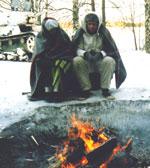
Staying
warm between takes.
Ben StroutOther
precautions helped keep the crew and actors from freezing. Besides
multi-layered cold weather clothing,
including triple socks
and double gloves, several bonfires burned bright at the edge of
the set. Actors and crew huddled around them between takes. By the
end of the day, the fire pit had descended several feet as the ice
beneath it melted. Make up was housed in a heated tent - another
place of refuge from the cold. A field kitchen supplied hot soup
and drinks. Several Finns repeatedly commented that the weather wasn’t
that bad at all- not nearly as cold as the minus 40 and 50 degrees
celsius during the Winter War. And of course, at the end of the day,
we defrosted in our hotel’s sauna.
Each day, as we filmed the battle scenes, we had a team of paramedics with their ambulance on hand, just in case. Recreating combat can sometimes be as dangerous as the real thing. Each scene was first moved from the script’s verbal description to a visualized storyboard treatment. These scenes were then run through on site several times. First time through, the stuntmen and the stunt coordinator choreographed the action. Next, the special effects director plotted and timed his explosions. He placed sequentially numbered flags at each explosion location, indicating the order in which they would be detonated.
Use of Explosions
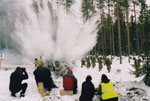
Filming battle scenes.
Ben Strout
Once the scene was completely worked out, the special effects crew began rigging their explosions. First they dug shallow holes and placed metal pans into them. The pans would control and shape the direction of the explosions. Next, they placed sticks of real dynamite on the pans and ran wires to a detonator sequencing board. Each dynamite charge was then covered with several bags of peat moss. The bigger the dynamite charge, the more peat moss was used to cover it. The peat moss would absorb the explosive power of the dynamite, and fly into the air, simulating the impact of artillery, tank or mortar shells. Finally each charge was covered with snow. After a final rehearsal, with cast, crew and special effects team, the flags were removed and the cameras were set to roll.
As we were filming one scene, one of the stuntmen became a bit disoriented and ran right over the explosive charge just as it detonated. He was enveloped by the explosion. Everyone rushed over, the paramedics in the lead. Fortunately, he was uninjured, just a bit stunned. And like a true stoic Finn warrior, he washed his hands and face in snow and said he was ready for the next scene. Needless to say, that shot is totally realistic.
In this, as in all things, the most vivid and long term memories are those derived through hardship and even acute pain. It was true for us in making Fire and Ice: The Winter War of Finland and Russia, even more so for those who experienced the Winter War. We hope our effort has honored them all.

